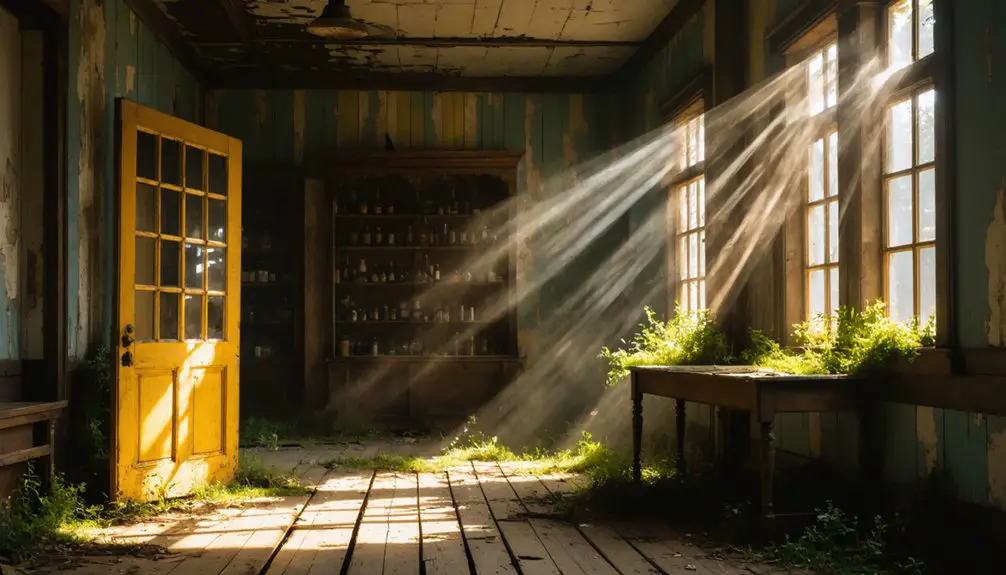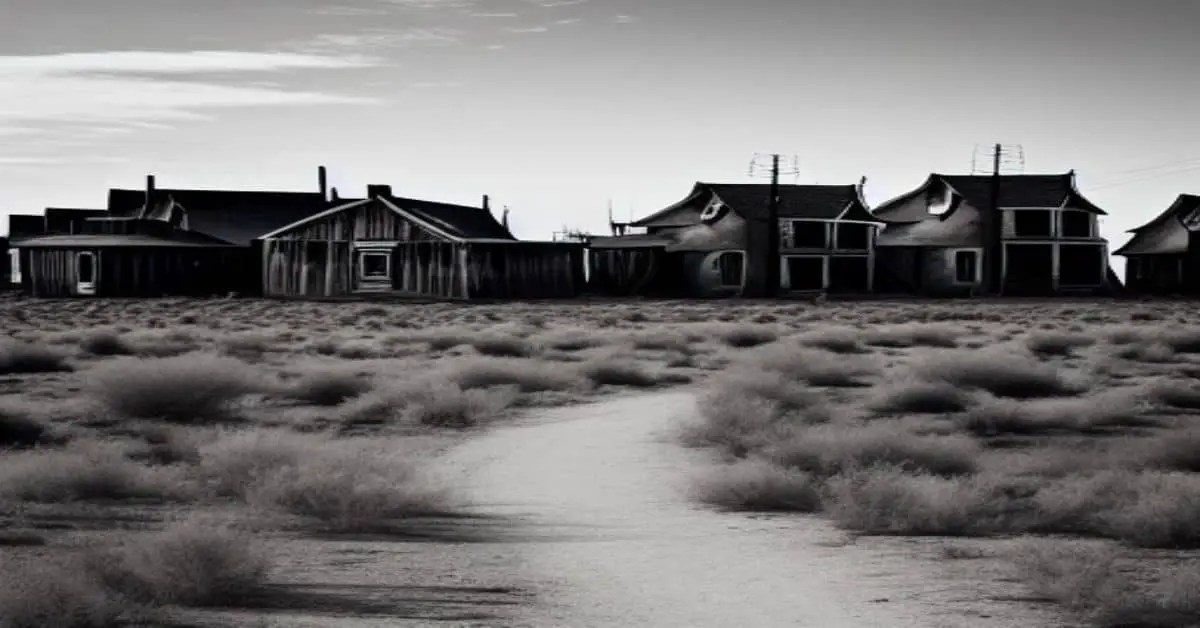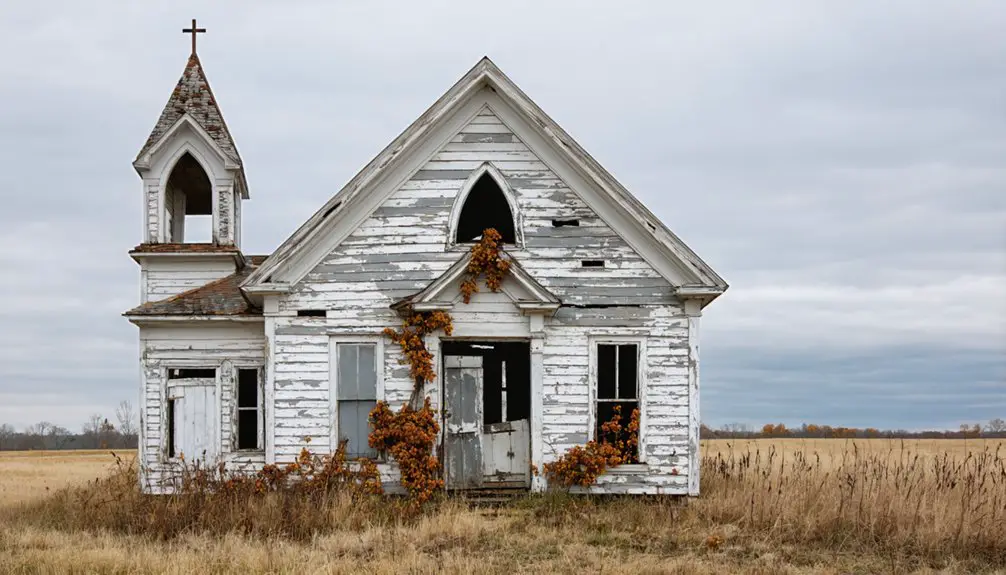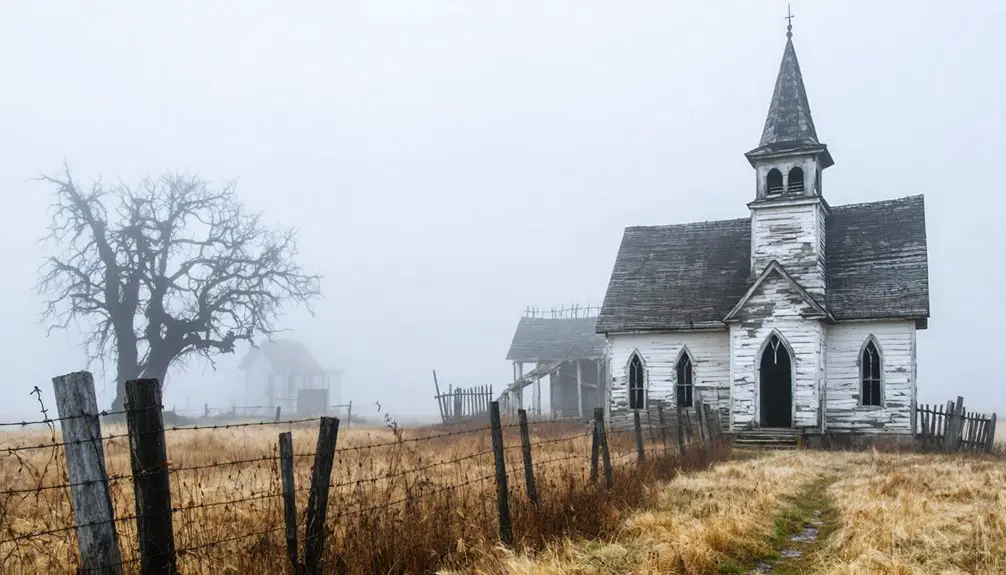You’ll discover the haunting story of Columbia, a former river port settlement at the Missouri and Mississippi Rivers’ confluence that nature reclaimed after persistent flooding drove settlers away. The abandoned town transformed into today’s Columbia Bottom Conservation Area, spanning 4,256 acres of wetlands, forests, and river frontage. Modern visitors can explore hiking trails and educational exhibits while experiencing the untamed spirit that challenged those early pioneers – a spirit that still echoes through the conservation area’s wild spaces.
Key Takeaways
- Columbia Settlement attempted to establish a river port at Missouri-Mississippi confluence but failed due to persistent flooding and wetland issues.
- The abandoned settlement transformed into Columbia Bottom Conservation Area, spanning 4,256 acres with 6.5 miles of river frontage.
- Nature reclaimed the ghost town after 1870, creating a thriving wetland ecosystem with native vegetation and floodplain forests.
- Early settlers faced severe challenges including floods, disease outbreaks, and agricultural difficulties, leading to the town’s eventual abandonment.
- The conservation area now preserves Missouri’s natural heritage while offering recreational activities and educational opportunities for visitors.
The Rise and Fall of a Frontier Settlement
While many frontier settlements flourished along America’s major waterways, Columbia’s ambitious plans to establish a thriving river port ultimately succumbed to nature’s constraints.
Today, the area serves as Columbia Bottom Conservation Area at the meeting point of two mighty rivers.
You’ll find that the town’s settlement strategies initially seemed promising, with its location at the confluence of the Missouri and Mississippi Rivers offering potential economic viability through trade.
Yet despite being replatted as St. Vrain, the community couldn’t overcome its wetland foundation. The persistent flooding and unstable terrain made it impossible to develop lasting infrastructure or maintain a permanent population. Like the haunting tale of Van Horn Tavern, the settlement’s troubled history left an indelible mark on the region.
Nature ultimately triumphed over ambition as wetlands and floods prevented St. Vrain from establishing permanent roots in the region.
By 1870, you would’ve witnessed both Columbia and St. Vrain’s complete abandonment, as residents relocated to more stable nearby communities like Arlington.
The land’s inherent challenges prevented any significant industrial or agricultural development, leading to its eventual transformation into today’s conservation area.
Nature’s Reclamation of Columbia’s Past
After Columbia’s abandonment, nature methodically reclaimed the ghost town’s footprint, transforming the failed settlement into a thriving wetland ecosystem.
Nature’s restoration swept away the town’s foundations through seasonal flooding, while native vegetation recolonized the landscape. You’ll now find thick patches of sunflowers and floodplain forests dominated by cottonwood, sycamore, and silver maple trees. The Cottonwood River floods repeatedly altered the landscape, contributing to the area’s transformation into wetlands. The Great Flood of 1993 led to widespread land condemnations that ultimately helped establish the conservation area.
The return to ecological balance brought diverse wildlife back to the area. The wetlands serve as a sanctuary for migratory birds, while beavers and muskrats have established themselves along the 6.5 miles of river frontage.
The confluence of the Missouri and Mississippi Rivers continues to shape this dynamic environment, where natural flooding cycles maintain the rich bottomland soils that once attracted settlers.
Life in the Bottomlands: Early Settler Challenges
You’ll find that early Columbia settlers faced relentless challenges in the bottomlands, where limited water access due to bedrock formations increased their vulnerability to diseases and sanitation issues.
The harsh agricultural conditions meant families had to clear dense oak and hickory forests while contending with difficult soil that required intensive labor to cultivate crops. Much like the early pioneers at Columbia Air Liners, these settlers had to demonstrate remarkable resilience in the face of adversity. Led by pioneers James and John Gray, the first settlement Smithton was established in 1818 before being renamed Columbia.
Working the land became even more demanding as settlers struggled with flooding risks and inadequate shelter in poorly insulated log cabins that offered little protection from extreme weather.
Disease and Flooding Impact
Before the Columbia Conservation area became protected land, early settlers faced a devastating combination of disease outbreaks and relentless flooding that ultimately led to the region’s abandonment.
You’ll find that typhoid fever ravaged the community in the 1950s, but disease outbreaks had plagued settlers since the 19th century due to poor sanitation and contaminated water sources in the bottomlands. The area’s position near the river confluence made flooding particularly severe and unpredictable.
The flooding effects proved equally destructive, as the confluence of the Missouri and Mississippi Rivers repeatedly inundated homes, crops, and infrastructure. Much like the Great Depression era that devastated Missouri’s farmland economy, these natural disasters wreaked havoc on the local population.
You’d have witnessed families struggling against waterborne illnesses while rebuilding after each flood, their resources constantly drained.
The damp environment fostered mosquitoes and respiratory problems, while isolation from medical care increased mortality rates.
These combined challenges eventually forced residents to abandon their dreams of establishing permanent settlements.
Harsh Agricultural Conditions
Despite the rich organic matter found in Missouri’s bottomland soils, early settlers faced formidable agricultural challenges in the Columbia Conservation area.
You’d have found yourself battling unpredictable floodplain agriculture conditions, where high-velocity floods could scour away your crops and alter field conditions overnight. The soil variability meant you couldn’t farm uniformly – one patch might be sandy and dry while another remained waterlogged and unsuitable for plowing.
You’d have needed to carefully select your planting sites, watching for signs like hardwood trees that indicated better-drained soils. While some areas could support crops without fertilizer for years, you’d have constantly fought against wetland shrub invasion and the remnants of bottomland forests.
The dynamic environment demanded continuous adaptation as river channels shifted and flood patterns changed. Farmers often struggled to maintain their land, as the soil erosion rate remained a significant challenge until conservation efforts began in 1982.
From Urban Dreams to Conservation Reality
While early settlers envisioned a thriving urban center at the confluence of the Missouri and Mississippi Rivers, nature had different plans for Columbia Bottom. The urban dreams of establishing Columbia, later re-platted as St. Vrain, Missouri, succumbed to persistent wetland conditions by 1870. Similar to the Baskett Research Area established in 1939, this land would find new purpose in conservation.
What began as a failed town eventually transformed into a conservation reality through the formation of the Columbia Bottom Conservation Area in 1997.
- 4,256 acres of restored natural habitat featuring 6.5 miles of river frontage
- Modern amenities including a visitor center and overlook for public enjoyment
- Strategic location connecting to Jones-Confluence Point State Park, creating an extensive conservation network
Today, you’ll find this land serves a higher purpose – preserving Missouri’s natural heritage while offering recreational opportunities that connect you with the untamed spirit of the rivers.
Legends and Lore of the Abandoned Town
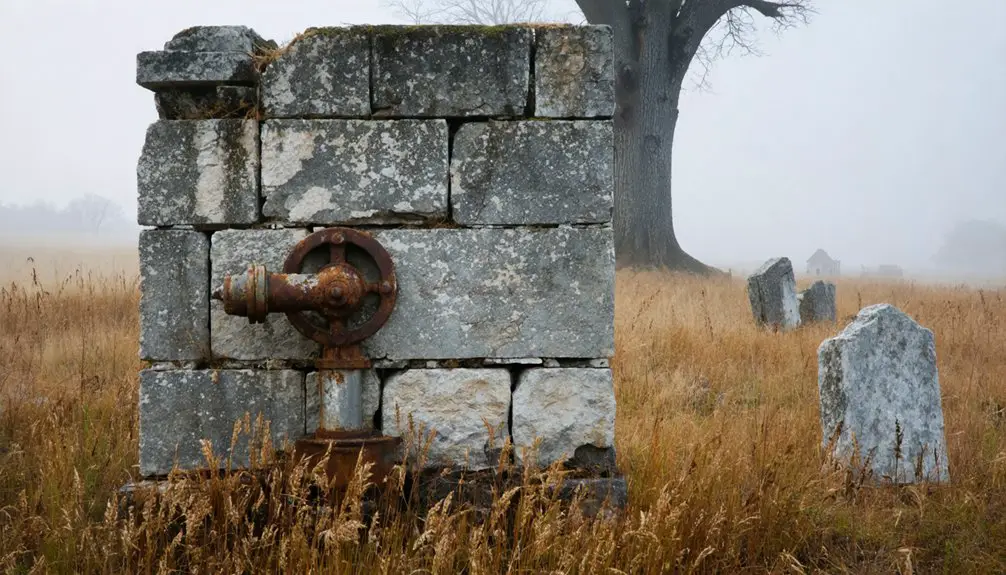
You’ll find the abandoned town‘s most enduring stories in its pioneer-era hauntings, particularly the well-documented cases of Jewell Cemetery and Van Horn Tavern.
At Jewell Cemetery, the ghost of Cynthia E. Jewell reportedly wanders near Providence Road, while the Van Horn Tavern’s haunted room revealed its grim secret when a child’s skeleton was discovered behind its walls.
These supernatural tales interweave with Civil War history, creating a rich tapestry of local lore that continues to captivate researchers and residents alike.
Haunted Pioneer Stories
Throughout Columbia’s pioneer history, chilling tales of restless spirits and unexplained phenomena have woven themselves into the fabric of local lore.
Pioneer hauntings range from the mysterious disappearance of Cynthia E. Jewell to the haunted Van Horn Tavern‘s ghostly encounters, where a child’s skeleton was discovered behind its walls.
- You’ll find the spirit of Cynthia Jewell wandering near her cemetery, with stories suggesting she either died in childbirth or fled to Mexico with a slave.
- At Van Horn Tavern, you might encounter the ghost of a murdered child, whose presence was so powerful that no guest would stay the night.
- In the Columbia Bottom Conservation Area, you can explore the empty remnants of St. Vrain, where pioneer settlements mysteriously vanished into the wetlands by 1870.
Civil War Spirit Sightings
As the Civil War tore through Columbia’s social fabric, it left behind more than just physical scars – it created enduring spiritual echoes that still resonate today.
You’ll find ghostly encounters tied directly to the town’s darkest moments, from the lynching of freed slaves by Confederate bushwhackers to the brutal neighbor-against-neighbor violence that defined the era.
The most chilling spectral histories emerge from buildings that served as Civil War morgues, where Confederate soldiers’ spirits reportedly linger in basements.
At Columbia College, you might glimpse the “Grey Lady,” a tragic figure who leapt to her death after losing her Confederate fiancé to Union forces. Her apparition, still donning mourning grey, opens windows and performs small acts of kindness – a gentler remnant of those violent times.
Preserving Missouri’s Ghost Town Heritage
Missouri’s ghost towns represent vital pieces of the state’s historical fabric, each telling unique stories of economic shifts, environmental challenges, and community transformations.
You’ll find ghost town preservation efforts ranging from maintaining original foundations at Old Greenville to repurposing Times Beach’s last standing building as an educational center.
Community engagement through heritage tourism and interpretive sites helps keep these historical narratives alive for future generations.
Heritage tourism and historical sites allow communities to preserve and share ghost town stories across generations of Missourians.
- Experience preserved streets and pathways that let you walk through 200-year-old town layouts
- Visit converted spaces like Times Beach’s visitor center where you can learn about environmental impacts
- Explore documented histories through media presentations and educational programs
These preservation strategies guarantee that even when physical structures fade, the lessons and legacy of Missouri’s ghost towns endure.
Exploring the River Confluence Today
When visiting the Columbia Bottom Conservation Area today, you’ll discover a remarkable 4,256-acre natural sanctuary where the Missouri and Mississippi Rivers merge to form North America’s fourth-largest river system.
You can observe the powerful river dynamics from the Confluence Viewing Platform, constructed in 2002 to showcase this magnificent junction.
The area’s habitat diversity is easily explored through eight educational stations along the main road. You’ll find wetlands, forests, prairies, and croplands teeming with wildlife, particularly birds drawn to the mixed environments.
Whether you’re hiking the trails, fishing the 6.5 miles of riverfront, or learning at the visitor center, you’re free to experience this preserved floodplain that was once slated for development before the Great Flood of 1993.
Frequently Asked Questions
Are There Any Artifacts From the Original Settlement on Display Nearby?
Though you’d hope to find tangible links to the past, there aren’t any known artifacts from the settlement on public display nearby, despite the area’s historical significance and preservation efforts.
What Native American Tribes Inhabited the Area Before Columbia’s Establishment?
You’ll find rich Native tribes’ cultural heritage in this area, where the Missouria, Osage, and Oneota peoples thrived, later joined by Kickapoo, Shawnee, and Delaware tribes before Columbia’s establishment.
How Did Mail and Supplies Reach the Settlement During Its Existence?
Like arteries feeding a crucial outpost, you’d find mail delivery and supply routes relied heavily on riverboats along the Missouri-Mississippi confluence, while limited wagon trails served when water levels permitted.
Were There Any Notable Crimes or Incidents During Columbia’s Brief History?
You’ll find limited evidence of documented crime incidents, though historical investigations mention an unsolved child death at Van Horn Tavern and mysterious circumstances surrounding Cynthia Jewell’s death.
Did Any Families From Columbia Relocate Together to Form Another Settlement?
While you might expect families to stick together, there’s no evidence of collective migration from Columbia. Historical records suggest displaced residents followed typical 19th-century settlement patterns, dispersing individually to established nearby communities.
References
- https://insidecolumbia.net/entertainment/haunted-history-a-peek-into-columbias-ghostly-past/
- https://legendsofkansas.com/columbia-ghost-town/
- https://www.onlyinyourstate.com/trip-ideas/missouri/road-trip-through-mo-ghost-towns
- https://en.wikipedia.org/wiki/Columbia_Bottom_Conservation_Area
- https://www.stlmag.com/news/new-plan-for-columbia-bottom-missouri-department-of-conservation/
- https://www.youtube.com/watch?v=3ElM_xAtbAY
- https://en.wikipedia.org/wiki/Category:Ghost_towns_in_Missouri
- https://en.wikipedia.org/wiki/Columbia
- https://missourilegends.com/2024/01/30/history-of-columbia/
- https://comomag.com/2014/07/01/columbias-founding-fathers/
